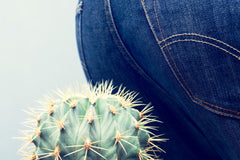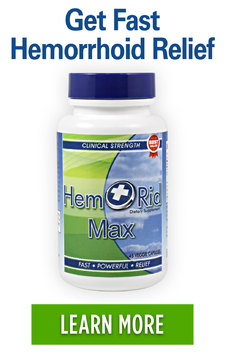Do Piles Hurt? What You MUST do When Internal and External Piles Hurt
Posted on 03 September 2018 by Maryanne Johnson
Share this post
Want to know why you're piles hurt? You may have heard of piles from older adults in your family or perhaps you are experiencing the many symptoms of piles.
Many people do not realize there are two types of piles and the question of whether or not this common anorectal condition hurts depends on which one you have.
Piles can be challenging, frustrating, and painful, and anyone who has had them previously or is currently experiencing them is well aware of the upheaval these inflamed anal cushions cause.
Your favorite activities may be more challenging to engage in, or what were simple movements now cause pain and discomfort.
In the UK, piles are so prevalent that there is a 50/50 chance of adults developing haemorrhoids during their lifetime. Many haemorrhoid sufferers do not seek help or tell their GP that they are experiencing symptoms of piles.
As piles progress, withholding the condition from your GP can be detrimental, but not fatal. Piles will worsen if you do not seek medical advice and treatment, and worse, sometimes complications can arise and can cause tremendous pain. Complications can develop from either type of pile, internal or external.
What Do Piles Feel Like?
If you are unfamiliar with piles, you may be confused as to what this common anorectal condition feels like and if it is painful. Many people experience hemorrhoids in mild forms, but even when piles are not severe, they can still be painful.
Piles appear similarly on just about everyone, and the symptoms of piles can slightly vary, but many patients report:
- Anus collecting faecal matter, mucus, and rectal discharge
- Anal irritation
- Rectal burning, pain, and soreness
- Fleshy sacs of inflamed blood vessels around the anus
- Discomfort and pain while passing poo
- Complications like protrusion or thrombosis
Piles are often described as "varicose veins" of the anorectal area. The reason why piles occur has much to do with the veins running through the rectal area and transferring the abundant blood supply.
If the blood flow is compromised, these veins can become inflamed, and its aggravation and irritation take the form of piles.
Piles, if you have never experienced them, are a collection of swollen blood vessels, smooth rectal muscles, arteries, and various inflamed connective tissues.
When the vascular channel becomes displaced or shifts because of interrupted blood flow, the result is piles.
External piles and internal piles are one in the same. Regardless of its location, hemorrhoids are swollen anal cushions in the lowest part of the rectum and take the shape of fleshy distortions.
However, symptoms differ depending on where the piles have formed, and this will alter how they feel.
When the blood flow affects the veins beneath the skin on the external portion of the rectal area, piles take shape as tender lumps, clustered around the anus. The nerves have a more potent sense of feeling in this area, and external piles signal more pain than its internal counterpart.
Why Do External Piles Cause Pain?
Piles that form externally can be seen and felt, making them a nuisance during regular activities and especially when going to the toilet. These aching bumps can be disruptive and inconvenient, even when they are a small, mild case of piles.
On occasion, and especially if the patient has acute constipation or other chronic gastrointestinal issues that cause disorder in bowel regularity and normalcy, an external cluster of piles will become thrombosed.
Chronic and symptomatic external piles often endure thrombosis and medically are recognized as a minor complication.
Thrombosis is the occurrence of a blood clot trapped in the venous channel, causing extreme and sudden pain.
There is more pain felt in a thrombosed haemorrhoid than a mild or moderate haemorrhoid that is not affected by thrombosis.
Do Piles Hurt When You Sit?
Sitting becomes unbearable for haemorrhoid sufferers cursed with a thrombosis. The thrombosed hemorrhoid may appear engorged and look purple or blue.
Many people with thrombosed hemorrhoids opt to use an inflatable cushion designed to make sitting positions more tolerable. While creams and lotions are available to target the sharp pain associated with externally thrombosed piles, it is best to have the piles lanced open and drained by your GP.
By doing so, you can aim to lower the risk of infection if the thrombosed pile should rupture on its own.
External hemorrhoids and what you should know:
- Appear as bumps on your skin around your rectum
- The bumps often hurt and interfere with activities, movement, and going to the toilet
- Tend to produce more pain in comparison to internal haemorrhoids
- Can still produce symptoms of itchiness and anal discharge
- Can make going to the toilet and bowel movements more arduous
Alternatively, internal hemorrhoids are located in the lower part of the rectal canal, but still caused by the same constrictions and disrupted blood flow as external hemorrhoids.
Internal hemorrhoids, in mild and even moderate cases, do not hurt because unlike external hemorrhoids, there is less of a presence of pain-sensing nerves.
Do Internal Hemorrhoids Cause Pain?
Internal hemorrhoids protrude inside of the anal canal, and the swelling of the displaced anal cushions can catch on passing stools.
Patients who suffer from chronic constipation typically have stools that are devoid of moisture, hardened, and challenging to pass.
Stools such as this can tear as they pass over internal piles when traversing through the anal canal.
While this scraping over internal piles and causing rectal bleeding sounds painful, it is not the case.
Most people are unaware that their internal piles are even present and will only notice them if they spot the occasional bright red blood in the toilet bowl afterwards.
Internal piles can be uncomfortable if they extend beyond the rectum. Prolapsed haemorrhoids are ranked in differing Grades, which categorize the state of the protrusion extending past the anus.
If your piles have collapsed outside of the rectum, you may feel a pinching sensation, or a lump coming out of your anus.
Rubber band ligation is a common approach in treating early stages of prolapsed hemorrhoids.
By cutting off the supply of blood at the base of the haemorrhoid, the column then falls off on its own. Ligation can be completed in about three office visits in a matter of an hour or less.
Band ligation has proven successful, and many patients report not having reoccurring hemorrhoids or hemorrhoid protrusions.
This outpatient procedure is considered to be relatively painless, with only a feeling of slight pinching and discomfort.
What to Do for Your Hemorrhoid Pain
There are temporary remedies that can be tried in the comfort of your own home if you are experiencing hemorrhoid pain.
Anti-itch and numbing creams, lotions, and balms are widely available to use and can be safely applied as directed for most patients.
Treating symptoms of hemorrhoids can lessen irritation and in direct correlation, can allow the hemorrhoids time to heal and reduce in size, eventually going away by themselves.
Even without treatment, however, hemorrhoids should disappear within a few days to a week.
As stated previously, an inflated cushion makes sitting easier and is fairly discreet if you desire to use it in public places.
External piles and even prolapsed piles can make sitting on hard surfaces such as benches or chairs uncomfortable, and this is especially true for extended periods of time.
Similarly, a warm bath offers comfort and relaxation, though studies have doubted whether sitz baths reduce swelling and inflammation of external piles.
Still, the applied heat and the desired additives like Epsom salts or essential oils can relieve stress, relax rectal muscles, and temporarily alleviate acute pain, at the very least.
Focusing your efforts on modifying your diet and lifestyle is the most effective way to treat your hemorrhoid pain.
Do Piles Hurt When You Poop?
Think about what may cause strain on the toilet; is it your diet? Do you get enough exercise? Are you drinking plenty of water?
Not only will doing these tasks reduce the occurrence of hemorrhoids but the pain you may feel while straining in performing bowel movements.
Because constipation is a primary factor behind the swelling and enlargement of blood vessels and the straining contributes to the restriction of your rectal venous channels, working to alleviate constipation will effectively reduce the hemorrhoids and subsequently the painful symptoms that follow.





0 comments